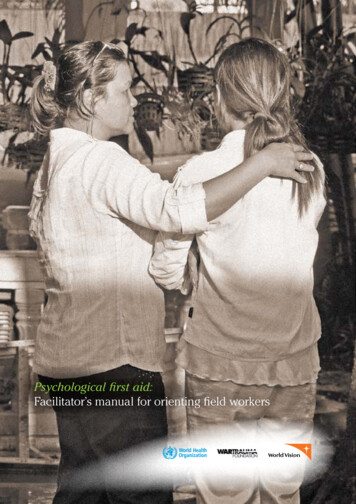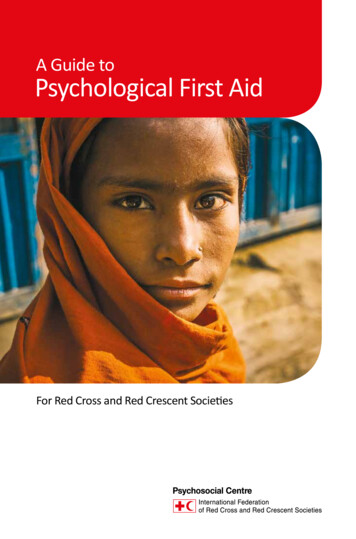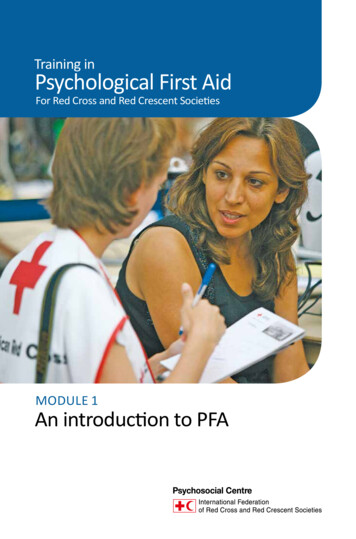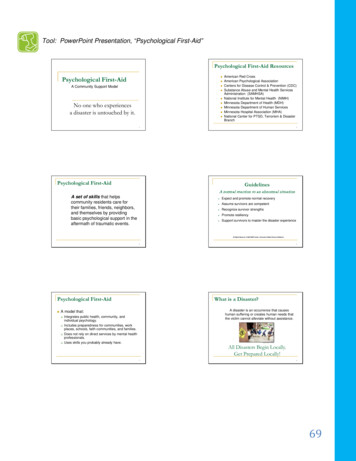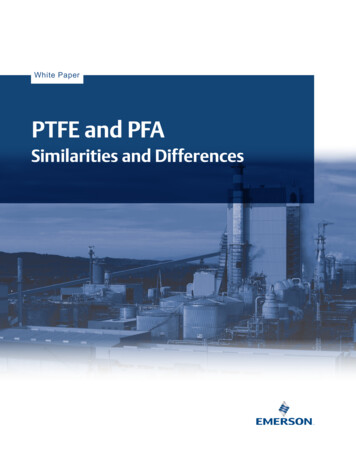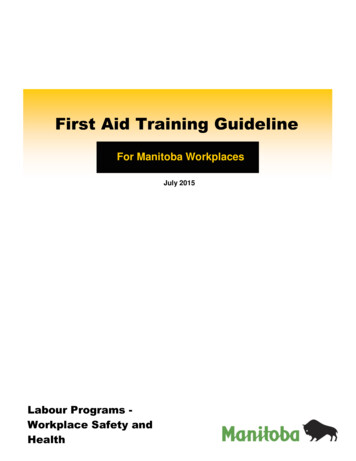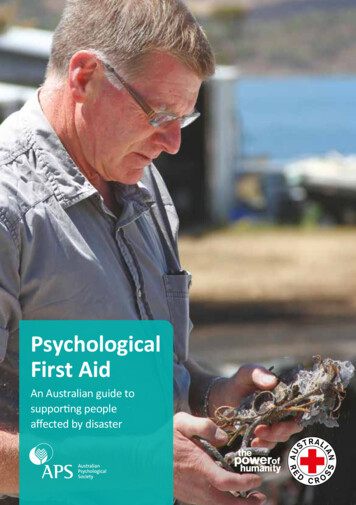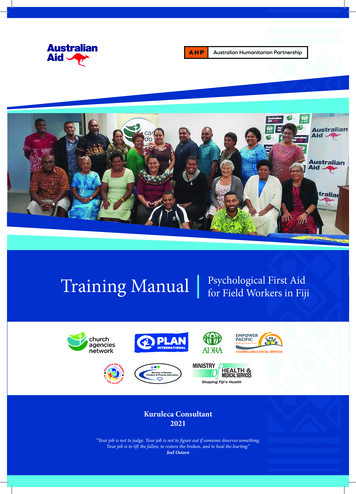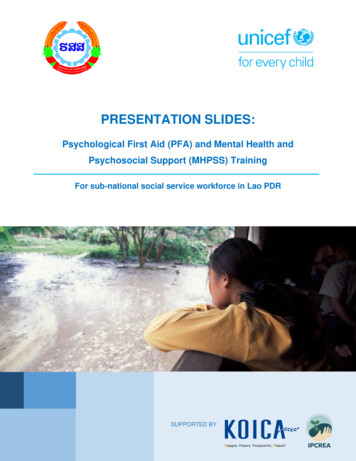
Transcription
PRESENTATION SLIDES:Psychological First Aid (PFA) and Mental Health andPsychosocial Support (MHPSS) TrainingFor sub-national social service workforce in Lao PDRSUPPORTED BY0
Cover photo: ️UNICEF Laos/ 2004/ Jim Holmes1
PRESENTATION SLIDES:Psychological First Aid (PFA) and Mental Health andPsychosocial Support (MHPSS) TrainingFor sub-national social service workforce in Lao PDR2
3
Table of ContentsMODULE 1: Understanding Crisis and Its Impacts5MODULE 2: Introduction to Psychological First Aid (PFA) andMental Health and Psychosocial Support (MHPSS)MODULE 3: Practice and Self-care28574
PRESENTATION SLIDES:Psychological First Aid (PFA) and Mental Health andPsychosocial Support (MHPSS) TrainingMODULE 1: Understanding Crisis and Its Impacts5
Presentation Slides: PFA and MHPSS Training - Module 1: Understanding Crisis and Its ImpactsSlide 1Psychological First Aid (PFA) and MentalHealth and Psychosocial Support (MHPSS)TrainingDay 1: Understanding Crisis and Its ImpactSupported by MoLSW, UNICEF Lao PDR and KOICATrainer: Manivone Thikeo, MD, MPH, Ph.D.Consultant for MHPSSTel: (856-20) 595360801Slide 2Introductionto the trainingIntroduction of the trainingIce breaker exercise to get to know each otherTraining objectiveAgendaTraining ground rulesTraining expectations from participantsPre-test26
Presentation Slides: PFA and MHPSS Training - Module 1: Understanding Crisis and Its ImpactsSlide 3Training ground rules Read the materials before training each dayCome in with questions to discuss if anyBe on time after breaks.Mute your cell phonesDo not interrupt someone who is speaking. Be an active listener.Respect others’ opinions.Participate fully in exercisesAlways give feedback this way: First, what went well? Then, what can be better?During the training, participants may recall stressful personal experiences, whichis normal. Reassure participants that they are under no circumstances obliged toshare anything private. The trainer is there to help participants to learn.Keep confidentiality. Stories stay in this room.3Slide 4Learning Goals At the end of the day, participants have increased understanding of what is a crisis eventand what impacts it can create on individuals and communities, physically, psychosociallyand mentally. Understand the concept of psychological and mental well-being, stress, trauma, disasterand the importance of delivering PFA and MHPSS support Be able to identify different types of stress, grief and mourning and introduce some basiccoping mechanisms. Understand the linkage between disaster, trauma and psychological/mental outcome Understand the link between disaster/pandemic and gender-based violence and childwell-being47
Presentation Slides: PFA and MHPSS Training - Module 1: Understanding Crisis and Its ImpactsSlide 5Exercise010203What kinds of crisisevents have youencountered in yourlife or work orsomeone you know?What physical, socialand psychologicalreactions did peoplehave?What was done tohelp and supportpeople?5Slide 6COVID-19 outbreak inLao PDRCORONAVIRUS in Lao PDR Number of infected cases: 41 Number of death due to COVID-19: 0 Number of children affected during theCOVID-19 related school closure: 1,440,733(52% are girls)(Source: MOH, UNICEF and WHO as of 19 Dec 2020)68
Presentation Slides: PFA and MHPSS Training - Module 1: Understanding Crisis and Its ImpactsSlide 7ExerciseDiscuss and list the ways the COVID-19outbreak has impacted your community.Who are most at risk and affected by COVID19 in Lao PDR?7Slide 8Examples of negative impacts of COVID-19 Full national lock-down Travel restriction Physical distancing and social isolation Increased violence and protection risks Unemployment Tensions within health systems Financial hardship Stigma and discrimination against recoveredpatients and families, and against health careworkers treating patients are infected School closure Limited access to social services Exhaustion of frontline workers89
Presentation Slides: PFA and MHPSS Training - Module 1: Understanding Crisis and Its ImpactsSlide 99Examples of people at risk oraffected by COVID-19 Those infected with COVID-19 Children, families and relatives of people infected People in quarantine and isolation People discriminated because they had COVID-19 Children separated from families, because ofhospitalization, death of families, etc. Children who cannot go to schools Labour workers Who else?Slide 10Common reactionsto COVID-19 FearAnxietyDepressionSadnessDifficulty in sleepingAngerGriefConfusedWhat else?10
Presentation Slides: PFA and MHPSS Training - Module 1: Understanding Crisis and Its ImpactsSlide 11Natural disasters11Slide 12Flooding and damcollapse in ATP 20181211
Presentation Slides: PFA and MHPSS Training - Module 1: Understanding Crisis and Its ImpactsSlide 13Disaster EventsA disaster is a critical incident that affects whole communities and causes massive,widespread, and collective stress and human suffering that requires assistance to recover.Major classifications of disaster: Naturally occurring (earthquake, hurricane, tornado, flooding, bushfire) Human-caused (war, genocide, terror, etc.) Pandemic (COVID-19, Swine Flu, etc.) Accident (car accident, airplane crash, building collapsed, etc.)13Slide 14ExerciseHow can disaster amplify the pre-existing problems? Can you share yourthoughts why certain people can be more vulnerable?1412
Presentation Slides: PFA and MHPSS Training - Module 1: Understanding Crisis and Its ImpactsSlide 15The Impact ofDisaster Disasters can create a wide range of problems experiencedat the individual, family, community and societal levels. At the individual level, disaster can create highdistress, anxiety, traumatic stress, etc. At the family level, disaster can interrupt familylife and separation of children from families,family financial hardship, etc. At the community level, people need to bedisplaced, community traditional events, festival,social life and other kind of activities thecommunity have been doing for generation canbe disrupted. At every level, emergencies disrupt available services,increase the risks of diverse problems and tend to amplifypre-existing problems. The psychological trauma as a result of an event ispowerful and upsetting incident that intrude on daily life.15Slide 16Cycle of psychosocial wellbeing in emergenciesSource of photos: Mercy Malaysia1613
Presentation Slides: PFA and MHPSS Training - Module 1: Understanding Crisis and Its ImpactsSlide 17Common reaction to disaster Majority of people show some change after a traumatic / distressing event.These reactions are normal and psychological stress will improve over time.Not everybody will be traumatized by those events.The majority will be distressed, only a small number will be chronic traumatized.Everyone reacts differently depend on different risk and protective factors.17Slide 18Impact onchildren,families andcommunitiesSocial impact on children: Relations with others (family, friends, teachers) due topsychosocial effects of disaster on children. New or changed roles, opportunities andresponsibilities (e.g. caring for siblings, drop out ofschool, work to support family).Impact on family functioning: Family tensions and increased family conflict due topoverty and less earning opportunity to parents orcaregivers. Change in roles & responsibilities, change familydynamic (financial impacts) i.e. fathers cannot earnmoney; mothers often have increased care burden.Impact on community functioning: Reduced resources - divisions and conflicts due tolimited existing resource and increase poverty andhunger.1814
Presentation Slides: PFA and MHPSS Training - Module 1: Understanding Crisis and Its ImpactsSlide 19Other situations that can negatively affectchildren Death of parents, other familymembers, friends, or neighbors Physical injury Separation from parents, family, andeven the community Violence or conflict in the household orthe environment surrounding the child Separation of parents (divorce) Poverty Conflict, tension, and violence in familyand community life School violence Sexual violence Any other multiple and prolonged formsof child maltreatment Displacement and refugee trauma Family members who have serious mentalhealth issues Witness to other traumatic events19Slide 20Gender Based Violence and Disaster The UN General Assembly defines violence against women as any act of gender-basedviolence that results in or is likely to result in, physical, sexual or psychological harm orsuffering to women (General Assembly Resolution 48/104 Declaration on the Elimination ofViolence against Women, 1993). GBV is any act of violence perpetrated against a person'swill because of socially ascribed power imbalances between males and females. Emergency disaster impacts on men, women, boys, and girls, vary greatly. The violence increased after the disaster because the lack of safety and surveillance Women and girls especially may feel more stress due to increased workloads and caregivingresponsibilities, and limited access to resources and services during and after disaster orpandemic. Women and children are more vulnerable and exposed to different risks, including GBV,Sexual, psychological, physical and emotional abuse. Although majority of the data on SGBV refers to women and girls as the largest groupaffected, GBV affects not only women, girls but also men and boys.2015
Presentation Slides: PFA and MHPSS Training - Module 1: Understanding Crisis and Its ImpactsSlide 21Gender Based Violence and Disaster- The study done by the International Federation of Red Cross i32n Oudomxayand Sekong after disaster showed increased GBV during and after disaster.The responsibility to prevent and respond to Sexual and Gender-Based Violence in Disaster and Crisis-Lao PDR. www.rcrc.resiliencesoutheastasia.org21Slide 22Gender Based Violence and DisasterThe responsibility to prevent and respond to Sexual and Gender-Based Violence in Disaster and Crisis-Lao PDR. www.rcrc.resiliencesoutheastasia.org2216
Presentation Slides: PFA and MHPSS Training - Module 1: Understanding Crisis and Its ImpactsSlide 23Gender BasedViolenceAgainstWomen andChildren23Slide 24Disaster Links toGender hy GBV risksincreaseduring andafter disaster?Can you think of ity toescapeabusivepartner2417
Presentation Slides: PFA and MHPSS Training - Module 1: Understanding Crisis and Its ImpactsSlide 25Crises typically disrupt a person’s life in manydifferent ways. One important characteristic is ‘loss.’Examples include:Critical EventsCharacteristic Loss Loss of personal relationships, close andsignificant loved onesControl over own life and futureA sense of security, hope and initiativeLoss of dignity, trust and safetyLoss of a positive self-imageLoss of trust in the futureSocial infrastructure and institutionsAccess to servicesProperty and material goodsprospects of a livelihoodLoss of opportunity to generate an income25Slide 26GriefGrief is the natural reaction to loss. Grief plays an important role in the understanding oftrauma. Grief is a strong, sometimes overwhelming emotion. Children experience griefdifferently; some have ongoing difficulties that can interfere in their everyday life.Five stages of grief (Kübler-Ross, 1969) Denial Anger Bargaining Depression Acceptance2618
Presentation Slides: PFA and MHPSS Training - Module 1: Understanding Crisis and Its ImpactsSlide 27What is stress? Stress is a normal reaction to a threat or a disturbing change in the environment (stressor)that caused both physiological and psychological responses.It occurs when any demand is placed upon the body.Stress is. Normal automatic physical reaction to the event. Necessary for survival, developmental, and growth. Preventable (avoidable). Manageable.27Slide 28Disaster and Stress Reaction Disaster events create both physical and psychological stress because peopleperceived that their life is under threat or challenge .Four phases of stress reaction phases:1. Acute phase.2. Reaction phase.3. Repair phase.4. Reorientation phase.2819
Presentation Slides: PFA and MHPSS Training - Module 1: Understanding Crisis and Its ImpactsSlide 29I. Acute PhaseAt this state, the acute stress reactions may: Last for minutes, hours, or days. “Fight or flight” mode response preparation for physical activity. Narrowing of focus decreases ability to think properly, Emotional reaction disbelief or consternation, lack of detachment. Rigid behavior irritability, anger, aggressive, violence, sad, cry, etc. affectscommunication. Panic rare but immediate attention needed.29Slide 30II. Reaction phaseAt this state, the stress reaction phase may: Last from one to six weeks. Have delayed reactions: previously repressed or denied feelings may surface. Be overwhelming, bringing powerless. Show characteristic reactions such as: Fear of returning to the site of the event. Dream of nightmares related to the event. Anxiety, restlessness, insomnia. Muscle tension, shaking or tremor and exaggerated startle response. Increase irritability and isolation, depression. Disturbing thoughts about survival, relief, guilt, grief.3020
Presentation Slides: PFA and MHPSS Training - Module 1: Understanding Crisis and Its ImpactsSlide 31III. Repair PhaseAt this state, the stress reaction repair phase may: Lasts for one to six months. Difference reaction less intense, and not so overwhelming. Feeling of pain and hurt continue but can be cope with. An interest now taken in everyday life. Plans made for the future.31Slide 32IV. Reorientation phaseAt this state, the stress reaction reorientation phase may:Lasts for approximately six months after a distressing event and continuing.Heightened stress reactions substantially reduced: Grief reaction may not be resolved but is accepted. Most reactions will diminish gradually. Assessing ongoing needs is important at this phase. 3221
Presentation Slides: PFA and MHPSS Training - Module 1: Understanding Crisis and Its ImpactsSlide 33Common reactions of children affected by disaster or traumatizing eventsReactions to TraumaTimingEmotionalImmediateAnger, Distress, FearMentalConfusion, DisorientationPhysicalCold sweats, DizzinessBehavioralAnnoys easily, BedwettingFeeling insecureInability to concentrateFatigue, NauseaDifficulty in expressionFeeling numb, GuiltMemory problemsRapid heart ratePoor grades at schoolHelplessness, sadnessRacing thoughtsShortness of breathRefusing to talk. RestlessnessStomach ache, Tight chestSelf isolation, SleepdisturbancesSense of hopelessness/emptiness/deep lossUncontrollable shakingStartled reactionsTearful for no apparent reasonDelayedAnxiety, DepressionFear of reoccurring traumaConstant remembering of bad Changes in appetiteexperiencesLowered resistance to coldsFlashbacks, Indecisivenessand infectionsHostility, IrritabilitySelf blame, Suicidal thoughtsEmotional detachmentAggression, Refusing to go toschoolRefusing to talk, Self isolationNightmares, Persistent fatigue WithdrawalSleep disturbancesMood swings, Shame33Slide 34Common reactions of children affectedby disaster or traumatizing eventsPre-school and young schoolage children (0-6):School-age children (7-12):Adolescents (13-18):-Feel unsafe at home or school. Struggle to focusin school and performance may decline.-Guilt or shame about thetraumatic events and mayfantasize about revenge andretribution.-Some youth may engage in selfdestructive or risky behaviors.-Feel helpless and exhibitfeelings of anxiety and fear.--Difficulty expressing thesefeelings in wordsGuilt or shame around their actions or inactionsduring a traumatic event.-Sleeping problems: nightmares, having a fear offalling asleep alone, or being unable to fallasleep.-Physical pain such as headaches andstomachaches, without an obvious cause to thepain.-Behavior change may occur with aggressiveand/or reckless behaviors.-Trouble sleeping alone andseparation anxiety.-Others will lose some speechand wet the bed.22
Presentation Slides: PFA and MHPSS Training - Module 1: Understanding Crisis and Its ImpactsSlide 35Common vs. Severe reactionSome examples of severe reactions that call for immediate attention and intervention and/orreferral: unable to sleep for a week or more and is confused and disorientated unable to function normally and care for themselves or their family (e.g., not eating orkeeping good hygiene and clean) lost control over their behaviour and is unpredictable or destructive threatens to harm themselves or others starts excessive or out-of-the-ordinary use of drugs or alcohol presents chronic health conditions which need specialised support presents symptoms of mental health disordersSlide 36What is trauma? Trauma can be defined as “a psychological, emotional response to a terrible event like anaccident, rape, or natural disaster or an experience that is deeply distressing or disturbingeffected psychological and physical well being of a person.” A traumatized person can feel a range of emotions both immediately after the event and inthe long term. They may feel overwhelmed, helpless, shocked, or have difficulty processing theirexperiences. Trauma can also cause physical symptoms such as pain in the body, numbness, headache,nausea and stomach upset.(the American Psychological Association)3623
Presentation Slides: PFA and MHPSS Training - Module 1: Understanding Crisis and Its ImpactsSlide 37Traumatic StressThere are two types of traumatic stress1. Primary traumatic stress--affects individuals and communities that are directly exposed to theelements of the critical event.- For example: people who were directly effected by dam collapsed in Attapeu Province2. Secondary traumatic stress can be incurred when an individual is exposed to people who havebeen traumatized themselves, disturbing descriptions of traumatic events by a survivor, or othersinflicting cruelty on one another.For example: social workers who interact with victims of trauma, witness horror event at thesite such as dead body from damp collapsed, flight crash in the Southern Lao PDR.(Source: CDC/ASPH Mental Health Preparedness Exemplars’ Group, 2005).37Slide 38Traumatic Stress ReactionSigns of traumatic stress reaction: The effected person can't stop thinking about the event. Being easily reminded of the event by thing that are not very related. Continuing to react fearfully even when the danger has passed. Increase difficulty controlling emotions. Having nightmares related to the event. Being easily irritated. Having a low tolerance for stress. Being easily startle. Losing a sense of reality.3824
Presentation Slides: PFA and MHPSS Training - Module 1: Understanding Crisis and Its ImpactsSlide 39PostTraumaticStressReactions39Slide 40Traumatic Stress ReactionEmotional numbness or extreme agitation. Immediate attention and coping assistance needed. Referral for professional care might be necessary. When referring: Important to inform the person concerned about your intentions. Recognize that such referrals may receive very negative reactions. Mental health referral may cause the affected person to be stigmatized andvictimized.4025
Presentation Slides: PFA and MHPSS Training - Module 1: Understanding Crisis and Its ImpactsSlide 41Secondary Trauma Secondary trauma or vicarious traumatization is “the transmission of traumatic stress toresponders by observing and/or listening to the stories of traumatic events.” It results when a responder's primary traumas are revisited due to the sights, sounds,stories, or issues raised by survivors. Helpers are at high risk to have secondary trauma if they are not prepared them wellbefore taking roles of helpers.41Slide 42Wrap UpSUMMARIZE 3 THINGS YOU LEARNEDTODAY.NAME 2 THINGS THAT WENT WELLTODAY AND SOMETHINGS THATNEED IMPROVEMENT.SHARE 1 QUESTION.26
Presentation Slides: PFA and MHPSS Training - Module 1: Understanding Crisis and Its ImpactsSlide 43References Inter-Agency Standing Committee (IASC). IASC Guidelines on Mental Health and Psychosocial Support in Emergency Settings. IASC:Geneva, 2007. Shultz, J. M., Espinel, Z., Galea, S., and Reissman, D. B., 2007b. Disaster ecology: implications for disaster psychiatry. In Ursano, R. J., etal. (eds.), Textbook of Disaster Psychiatry. Cambridge, UK: Cambridge University Press, pp. 69–96. World Health Organization, War Trauma Foundation and World Vision International (2011). Psychological first aid: Guide for fieldworkers. WHO: Geneva. International Federation of Red Cross and Red Crescent Societies. Centre for Psychosocial Support. Psychosocial Interventions.Blegdamsvej 27, DK-2100 Copenhagen Denmark: http://www.ifrc.org/psychosocial International Federation of Red Cross and Red Crescent Societies Psychosocial Centre. Basic training in Psychological First Aid forCOVID19 outbreak response adaptation and facilitation guide. https://pscentre.org/?resource d-crescent-societies Vinod Singaravelu MBBS, MRCPsych. Oxford, UK. Child & Adolescent Psychiatrist and Resilience Life Coach,Vinod.Singaravelu@yahoo.comAmerican Academy of Experts in Traumatic Stress aaets.org Herman, J. (1992) Trauma and Recovery: The Aftermath of Violence – from Domestic Abuse to Political Terror, New York: Basic Books.pg. 33. Psychotherapy Networker interview with Dr. Bessel van der Kolk January 11, 2017 explains43Slide 44AcknowledgementThis training is developed by the Ministry of Labour and Social Welfare andUNICEF Lao PDR through the generous support from KOICA.-END OF MODULE 1-27
PRESENTATION SLIDES:Psychological First Aid (PFA) and Mental Health andPsychosocial Support (MHPSS) TrainingMODULE 2: Introduction to Psychological First Aid (PFA) andMental Health and Psychosocial Support (MHPSS)28
Presentation Slides: PFA and MHPSS Training - Module 2: Introduction to PFA and MHPSSSlide 1Psychological First Aid (PFA) and Mental Healthand Psychosocial Support (MHPSS) TrainingDay 2: Introduction to PFA and MHPSSSupported by MoLSW, UNICEF Lao PDR and KOICATrainer: Manivone Thikeo, MD, MPH, Ph.D.Consultant for MHPSSTel: (856-20) 59536080Slide 2Training ground rules Read the materials before the trainingeach day. Come in with questions to discuss if any. Be on time after breaks. Participate fully in exercises. Always give feedback this way: First, what went well?Then, what can be better? Do not interrupt someone who isspeaking. Be an active listener. During the training, participants may recall stressfulpersonal experiences, which is normal. Reassureparticipants that they are under no circumstancesobliged to share anything private. The trainer is there tohelp participants to learn. Respect others’ opinions. Keep confidentiality. Stories stay in this room. Mute your cell phones.29
Presentation Slides: PFA and MHPSS Training - Module 2: Introduction to PFA and MHPSSSlide 3Learning ObjectivesUnderstandthe concept ofPFA and MHPSSand itsimportanceduring andafter crisisevents.Understandhow PFA andMHPSS can beprovided atdifferent levelof pyramid ofcareRecognizeguidingprinciples ofdelivering PFAand MHPSSRecognizecharacteristicof a goodhelperKnowwhen to referfor advancedandprofessionalassistanceSlide 4Exercise Have you ever supported people affected by disasters? If so, what support did you provide? What comes to your mind if you think about ‘mental health and psychosocialsupport’? Who can provide this kind of support, when, and where?30
Presentation Slides: PFA and MHPSS Training - Module 2: Introduction to PFA and MHPSSSlide 5What isMHPSS? Mental health is a states of mind that a person realizeshis/her own abilities, can cope with the normal stressesof life, can work productively and fruitfully, and is able tocontribute to his/her community. (WHO) Psychosocial support- Psycho is about feeling, thoughts, and emotions – the“inner” world of a child.- Social is about the external environment in which thechild lives – family, friends, school, community, etc. – allabout the relationships a child has with others.- Support is the way in which children are helped to copewith traumas and stress and to build resilience or theability to “bounce back” from adverse conditions orevents.Slide 6What is MHPSS? (continued) Psychosocial support refers to actions that providesimmediate relief suffering, both emotional andphysical, improve people’s short-term functioningand reduce long-term negative psychologicaleffects.(IRFC Psychosocial Framework) Mental health and psychosocial support refers toany type of local or outside support that aims toprotect or promote psychosocial well-being and/orprevent or treat mental disorder.(IASC Guidelines on Mental Health & Psychosocial Support inEmergency Settings, 2007)31
Presentation Slides: PFA and MHPSS Training - Module 2: Introduction to PFA and MHPSSSlide 7Characteristics of Psychological SupportImproves aperson’simmediateability tofunctionunder stress.Relievesemotionaland physicalsuffering.Mobilizes thepower fects.Slide 8Purposes of providingpsychosocial g asense ing asense of selfand collectiveefficacyHobfoll et al. (2007)32
Presentation Slides: PFA and MHPSS Training - Module 2: Introduction to PFA and MHPSSSlide 9MHPSS inDisaster Disaster and conflict often causesubstantial damages to materials andhuman life. While material can be fixed orreplaced, mental wound is often keptsecretly and need more time to heal from. MHPSS can reduce stress, strengthen anduse protective factors to help peopleaffected by crises recover. Mental health and psychosocial problemsin emergencies are highly interconnected.Slide 10Why do we provide MHPSS? Providing early and adequate MHPSS can prevent distress and sufferingfrom developing into something more severe. It is crucial to provide earlier mental and psychosocial in disaster andtrauma relief to help individuals, families, and communities deal withdistress, suffering, and sorrow and to ultimately recover.33
Presentation Slides: PFA and MHPSS Training - Module 2: Introduction to PFA and MHPSSSlide 11How MHPSS Can Be ProvidedSpecialized servicesFocused (person-to person)non -specialized supportsStrengthening communityand family supports432Social considerations in basicservices and security 1Slide 124 Layers of providing MHPSSLevel 1: can be done by inside and outside aids organizations which focus on reestablish security, safety & basic services (water, food, shelter & health services) –advocacy for basic services that are safe, socially appropriate & protect dignity.Level 2: can be done by inside and outside aids organizations that promote and / orprovide everyday activities such as schooling, activating social networks andcommunal traditional supports, supportive age-friendly spaces.34
Presentation Slides: PFA and MHPSS Training - Module 2: Introduction to PFA and MHPSSSlide 134 Layers of providing MHPSS (Cont.)Level 3: social workers and health staff can provide onsite for psychological first aid, basicmental health care by trained primary healthcare doctors or refer for outside service, provideactivities in child friendly spaces to support for basic emotional & other practical support asneeded.Level 4: services provide by mental healthcare specialists (psychiatric, nurses, psychologists,psychiatrists, etc.) Child Friendly Service workers refer person to specialist services fordiagnosis & support for those 6-8 weeks after emergence if still not showing signs ofimprovement.Slide 14Primary focus on physical and material care and protection people fromdanger.Immediate intervention: be direct, active and remain calmFocus on the “here” and “now” situationPrinciplesof providingMHPSSProvide accurate information about the situationDo not give false assurancesRecognize the importance of taking actionReunite with family membersProvide and ensure emotional supportFocus on strengths and resilienceEncourage self-relianceRespect feelings of others35
Presentation Slides: PFA and MHPSS Training - Module 2: Introduction to PFA and MHPSSSlide 15What is Psychological First Aids (PFA)PFA is a humane and supportive response to a fellow humanbeing who is suffering and who may need support. It is an acuteintervention of choice when responding to the psychosocialneeds of children, adults and families affected by disaster andpandemic.Source: Psychological First Aid for All, WHOSlide 16PFA involves seven areasPsychological First Aids (PFA)Protect peoplefrom furtherharmProvide practicalcare & supportAssess needs& concernsPFAListen but don’tpressure themto talkHelp with basicneeds (e.g. food,water,information)Comfort them &help them feelcalmConnect them toinformation,services & socialsupportDr. Vinod Singaravelu: PFA for field worker’s guide36
Presentation Slides: PFA and MHPSS Training - Module 2: Introduction to PFA and MHPSSSlide 17Psychological First Aid is “not” Not something only professionals can doNot psychological debriefingNot professional counselling or therapyNot encouraging a detailed discussion of the event that has caused thedistress, traumatic experiences and lossesNot asking someone to analyze what has happened to themNot pressing someone to talk for details on what happenedNot pressuring people to share their feelings and reactions to an event.Not something that everybody who has been affected by an emergency willneed.Slide 18The fundamental principle of Do No HarmSafety Avoid putting people at further risk as a result ofyour actions.M
Presentation Slides: PFA and MHPSS Training - Module 1: Understanding Crisis and Its Impacts Slide 25 s. : s e e ty lf-e e s s e 25 _ _ Slide 26 Grief Grief is the natural reaction to loss. Grief plays an important role in the understanding of trauma. Grief is a strong, sometimes overwhelming emotion. Children experience grief


